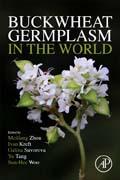
Buckwheat Germplasm in the World
Zhou, Meiliang
Kreft, Ivan
Tang, Yu
Suvorova, Galina
Buckwheat Germplasm: Global Resources, Characterization and Utilization presents a comprehensive overview on this globally important crop from its general characterization and genetic diversity, particularly in Russia, China, India and Eastern Europe, but globally as well. Presenting the latest information on molecular marker development, genetics and phenotype analysis of new wild buckwheat accompanies insights into the nutritional values of this pseudocereal crop. Due to its short growth span, ability to grow at high altitudes and the high quality of its protein content, buckwheat continues to be explored as an important crop for addressing the food needs of the world. Ideal for researchers and advanced-level students seeking better understanding of the buckwheat germplasm. Summarizes all the reported and distributed buckwheat species in this world. Researchers can exchange the resources each other to breed new cultivarsClassifies buckwheat species based on Perennial and Annual from their growth span, Self-incompatible and Self-compatible from their flower morphology and characterizationFacilitates hybridization of different species INDICE: 1. Overview of buckwheat resourses in the world 2. Classification and nomenclature of buckwheat plants 3. Distribution of buckwheat resourses in the world 4. Chromosome of Fagopyrum 5. Description of cultivated tatary buckwheat 6. Description of cultivated common buckwheat 7. Perennial wild Fagopyrum species-Self-incompatible 8. Perennial wild Fagopyrum species-Self-compatible 9. Annunal wild Fagopyrum species-Self-incompatible 10. Annunal wild Fagopyrum species-Self-compatible 11. Annunal wild Fagopyrum species-Partially self- compatible 12. Molecular evolution of wild species and cultivated 13. Utilazation of wild buckwheat species 14. Buckwheat genetic resources in the central Europe 15. Existing variability and future prospects of buckwheat germplasm in the Himalayan tract 16. Undefined title 17. Effective use of genome-wide markers to breeding for quantitative traits in common buckwheat 18. Genetic diversity of Russian buckwheat cultivars assessed from nuclear and organellar gene sequences 19. Genetic polymorphism of common buckwheat (Fagopyrum esculentum Moench.), formed from evolutionary mutation reserve of the cultivar 20. Cultivation of Fagopyrum tataricum and Fagopyrum esculentum in order to obtain raw material with high rutin content in the Far East of Russia 21. Phytochemicals and their biofunctional properties of different buckwheat germplasms for functional food 22. Rutin content assessment of Tartary buckwheat germplasm cultivated in Italy Topic: Grain rutin content evaluation of a collection of approximatively 100 F. tataricum accessions. 23. Correlation between grain yield and rutin content in common buckwheat germplasm cultivated in Southern Italy 24. Buckwheat resources in the VIR (Russia) collection: Photoperiod response 25. Main morphological types of cultivated buckwheat populations in Russia 26. Interspecific crosses between Fagopyrum cymosum and other species through embryo culture techniques 27. Cell cultures of Fagopyrum tataricum as a source of biologically active phenolic compounds Ch 28 Molecular genetics of Buckwheat and its role in crop improvement
- ISBN: 978-0-12-811006-5
- Editorial: Academic Press
- Encuadernacion: Rústica
- Páginas: 364
- Fecha Publicación: 01/01/2018
- Nº Volúmenes: 1
- Idioma: Inglés
